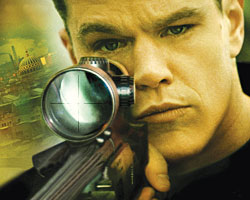 |
The Bourne Ultimatum, the third offering in the Bourne series, is distinguishable from its predecessor only in a matter of degrees. Jason Bourne once again attempts to piece together his past, while the nervous CIA attempts to eliminate him. Director Paul Greengrass has honed his craft from his previous projects, giving us more of what made the previous incarnation so successful. And Matt Damon has perfected the silent morose poses-leaving you to read all sorts of weighty and troubling thoughts on his furrowed brows and unsmiling face. Bourne is the Bond of our time: a glum, gritty, reluctant killer as opposed to the slick and glamorous spy of yesteryear.
Ultimatum engages both in a kind of escapism and fantasy: on the one hand the war on terror is banished to the faint margins of the frame; on the other hand, the CIA is fantastically equipped in tracking a determinedly elusive character (a certain turbaned bearded Saudi notwithstanding). And yet, the present situation in Iraq creeps into the film, albeit obliquely, mostly presented by the ripostes lobbed back and forth in the CIA war room that mirror the right and the left in American editorials and talk shows. For instance, the villainous Deputy Director of the CIA (David Strathairn), embodying the hawks' position, admits "mistakes were made" at the censure of subordinate Pamela Landy (Joan Allen), a tough blonde soft on Bourne (Hillary for president?), but chides her "armchair criticism". The flashbacks Bourne suffers are also loaded with images like hooded figures resonating with Abu Ghraib and other sundry torture scenes, and reflect the amnesia that seems to inflict the American populace. This kind of veiled political criticism is almost a habit for films coming out of Hollywood, as if the filmmakers feel that their audience needs a spoonful of sugar for their political analysis to go down.
Greengrass keeps the film at a clipping pace with its jittering, bobbing hand-held camerawork and cuts that are mere seconds long for much of the film. It works for a while, but even for the MTV generation the effect cloys rapidly. The breakneck pace means most of the film speeds past you, and even before you can make sense of one plot element, it has already become irrelevant.
The adrenaline-pumping action owes much to the agile camera work that follows the actors in the various cat-and-mouse scenes of good guys hunting bad guys hunting good guys. But it relies as much on the performances of the "assets," a euphemism for assassins in the employ of the CIA. Something akin to James Cameron's Terminators, they are dispassionate relentless killers who doggedly pursue their targets. Their silent menace and stifled morals have a strange gravity that grant weight to the movie. In one action scene that seems like the crux of the film, Bourne fights an asset, their dizzyingly choreographed duel ends with Bourne choking his opponent with a towel and Greengrass holds for seconds longer causing us to slip momentarily from being purely entertained into being sickly aware of the violence depicted. Here is one message the film articulates brilliantly: there is a high cost when we train people to kill.
Director: Paul Greengrass
Cast: Matt Damon, David Strathairn, Joan Allen, Julia Stiles, Edgar Ramirez
2007. R. 111 min.



